
American 19th Century, Detroit Photographic Company, Mississippi Cotton Gin at Dahomey, published 1899, photo-chromolithograph, Gift of Mary and Dan Solomon and Patrons' Permanent Fund, 2006.133.130
How did the Industrial Revolution modify the United States?
What makes industrialization possible?
How does fine art reverberate the varying experiences within a capitalist economy?
In 1899 an unknown lensman documented the interior of a cotton gin operation in Dahomey, Mississippi. The image reveals the challenging and stifling work of processing raw cotton in the humidity of the southern United States. In the foreground, African Americans pack and printing cotton into a massive bale. Others stand in the background next to cotton gins, machines that separated viscous seeds from plant fibers. Cotton clings to the walls and rafters of the room.
By 1860, 61 percent of the world's raw cotton originated in the southern United states of america. Nearly all of this cotton was grown and processed by enslaved African Americans on lands seized from Native Americans. The cotton was shipped to industrial giant Slap-up U.k., which imported 75 pct of its raw cotton from the United States, also every bit to factories in the northern United States, where the fiber was spun, dyed, woven, and printed. Cotton was key to the United States becoming a global economic powerhouse.
The commencement of the U.s.a. Industrial Revolution is oft dated to 1793, when the kickoff h2o-powered, roller-spinning textile mill opened in Pawtucket, Rhode Island. It was developed in part by Samuel Slater, an English fabric apprentice who memorized British mill designs—in defiance of British laws banning their consign—and and then immigrated to the United States.
This origin story introduces two themes that often feature in the larger narrative of industrialization: entrepreneurship and mechanization. It centers the Industrial Revolution in New England, where fabric mills proliferated due to fast-running rivers and where workers left farms for factories over the second half of the 19th century. Information technology likewise celebrates the United states as a champion of opportunity for immigrants who moved to the young country past the millions.
However, the story of the Industrial Revolution in the United States is also the story of slave labor, land exploitation, and Indian Removal. Mississippi Cotton Gin at Dahomey documents mechanized labor at what was one time the world'due south largest cotton fiber plantation. Situated in the soil-rich area known as the Mississippi delta, Dahomey Plantation was named after the homeland of its enslaved workers, the Kingdom of Dahomey in present-24-hour interval Benin.
The drive to industrialize, compete, and rapidly increase wealth in the Usa impacted people and lands unevenly. Artists, particularly photographers, were hired to gloat industrial achievements, particularly the structure of railroads. These same works of art oft reflect the unease, tension, and loss that resulted from such development. By looking at artwork from this period, how might we gain a fuller picture of the innovations and sacrifices that led to the growth of the United States?
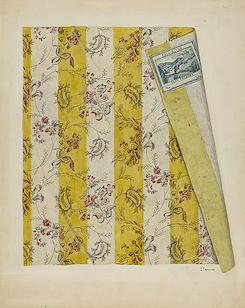
Industrial Revolution Joseph Lubrano, Printed Cloth, c. 1941, watercolor on paperboard, National Gallery of Art, Washington, Index of American Design, 1943.8.950
Cotton wool played a key role in the Usa' Industrial Revolution. By the mid-19th century, the Usa supplied 61 percentage of the globe'southward raw cotton wool, all of it grown in southern states. Textile mills in New England used raw cotton from the South to spin, dye, and eventually weave and print cotton fabric.
This material sample—rendered in watercolor by an artist hired in the 1930s—was produced by the Robeson Company in Fall River, Massachusetts, betwixt 1834 and 1848. The illustration is part of the Alphabetize of American Design, a drove of 18,257 watercolor renderings of American folk and decorative arts objects from the colonial period through 1900. Illustrators were hired by the federal government as part of a Depression-era piece of work-relief program to document the "usable past" and preserve a national aesthetic.
What slice of design or material culture from today would you preserve for hereafter generations?

Industrial Revolution American 19th Century, Textile Merchant, c. 1840, oil on canvas, National Gallery of Fine art, Washington, Gift of Edgar William and Bernice Chrysler Garbisch, 1953.v.81
By the 1840s, when this portrait was made, cloth mills had spread throughout New England. This merchant'south portrait is evidence of that growing manufacture. The sitter was affluent enough to commission his portrait and is shown in front of what made him wealthy. Rather than selling bulk textiles, all the same, this human probably supplied dry goods or manufactured dresses. Behind him are blueish boxes that would take probable independent hats; bolts of calico, a printed cotton wool fabric, sit on shelves. Multiple groups benefited from calico printing at this time, including factory owners, textile merchants, and those who created appurtenances using the cloth.
What markers of wealth and condition do you lot run into in your community today?
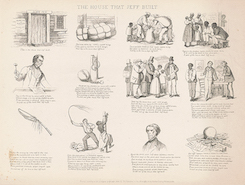
Industrial Revolution David Claypoole Johnston, The Business firm that Jeff Built, 1863, carving in black on wove paper, National Gallery of Art, Washington, Corcoran Collection, 2015.19.2810
Crops of all kinds flourished in the Southern The states due to its warm climate, moderate rainfall, and rich soil. However, cotton was a commodity in high demand in the 19th century, and its growth and processing were made easier by the invention of the cotton gin in 1793 and the discovery of a new cotton fiber species. These factors encouraged Southern planters to focus their growing efforts on the crop, and slaveholders increased their output past relying more than heavily on enslaved human capital.
The Firm that Jeff Built is an abolitionist political cartoon made in 1863 during the Ceremonious War. David Claypoole Johnston borrowed the construction of the British nursery rhyme "This Is the Firm That Jack Built" to illustrate how slavery and the cotton economy, led by Confederate President Jefferson Davis, were interdependent and dehumanizing.
According to this drawing, what is the downfall of the Confederacy?
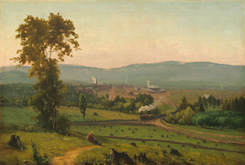
Industrial Revolution George Inness, The Lackawanna Valley, c. 1856, oil on sheet, National Gallery of Fine art, Washington, Gift of Mrs. Huttleston Rogers, 1945.4.one
The Delaware, Lackawanna, and Western Railroad, based in Lancaster, Pennsylvania, hired George Inness to depict and celebrate the railroad shortly subsequently its 1851 incorporation. Inness'southward painting features a train moving through a field of tree stumps, a sight increasingly mutual across the country as railroads were chop-chop constructed in the 2nd one-half of the 19th century. A roundhouse, depicted in the background, was not nonetheless finished when Inness made the painting, just his patron requested it exist included in the work.
Some scholars interpret this painting every bit an enthusiastic affidavit of industrial applied science. Others empathise it to be a lament for a rapidly vanishing wilderness. Given what you see in the painting, what exercise you lot recall this artwork's message is?
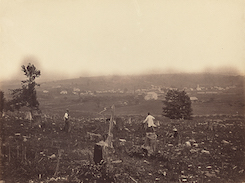
Industrial Revolution Thomas H. Johnson, Waymart, c. 1863–1865, albumen impress, National Gallery of Art, Washington, Gift of Mary and Dan Solomon, 2006.131.v
In 1863 Thomas H. Johnson opened a photographic studio in Scranton, Pennsylvania, where he had easy access to clients in the coal and railroad industries. The Delaware and Hudson Canal Company (who later congenital the Delaware and Hudson Railway) hired Johnson to create a serial of photographs depicting mining towns forth railroad routes. Delaware and Hudson played a major function in developing and operating coal mines in northeast Pennsylvania. In this photograph, Johnson focused his camera on Waymart, a town that had sprung up along the railroad.
Compare this photograph to George Inness'south painting, The Lackawanna Valley. What similarities and differences practice you run into?
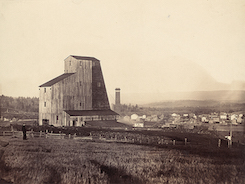
Industrial Revolution Thomas H. Johnson, Von Storch Shaft, Del. & Hudson Canal Co., c. 1863–1865, albumen print, National Gallery of Art, Washington, Alfred H. Moses and Fern 1000. Schad Fund, 2016.152.1
As function of a series documenting coal mines for the Delaware and Hudson Canal Company, Thomas H. Johnson set his camera upon this imposing structure set atop a mine opening in Scranton, Pennsylvania. Consider how Johnson shows the structure in comparison to the town and landscape. What practice yous think this photograph says well-nigh the coal manufacture?
There are more photographs of 19th-century railroads and industrial scenes than paintings. This is due in large part to the recent invention of photography in 1839. Photographers aligned themselves to modern industry and railroads preferred using the latest fine art form to promote their enterprise.
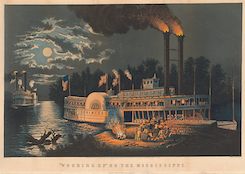
Industrial Revolution Frances Flora Bail Palmer, "Wooding Up" on the Mississippi, 1863, color lithograph with hand-coloring on wove paper, National Gallery of Fine art, Washington, Donald and Nancy deLaski Fund, 2011.thirty.1
Steamboats dramatically altered transportation in the United States in the late 18th and early 19th centuries. Powered by lumber or coal, steamboats replaced one-way flatboats, enabling faster two-manner travel via canals and rivers. They also held greater capacity for conveying goods. Steamboats hastened the spread of settlers into what is now the middle of the United States, especially along the Mississippi and Ohio Rivers.
"Wooding Upward" on the Mississippi from 1863 shows the showboat Princess stopping for fuel, perchance in a race with Diana behind it. African Americans, likely enslaved, load lumber onto the boat, while white patrons, some of them slaveholders, populate the upper deck. In this work, Frances Flora Bail Palmer may have been hinting at the dangers of steamboat travel: moonlight shines on a snag (or tree) in the river, and the glowing fires would have reminded viewers of the all-too-mutual event of transport explosions. Palmer likely knew nigh the 1859 explosion of the showboat Princess in New Orleans, when dozens died considering of faulty boilers.
Call up about the details and themes presented in this piece of work of art. If this paradigm appeared in a newspaper, what do you think the adjacent headline might read?
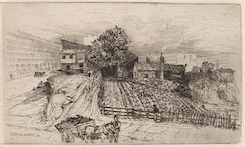
Industrial Revolution Mary Nimmo Moran, A City Farm—New York, 1881, etching in black, National Gallery of Fine art, Washington, Reba and Dave Williams Collection, Gift of Reba and Dave Williams, 2008.115.3579
Mary Nimmo Moran was widely celebrated every bit an skillful engraver in the 1880s and 1890s. Her depiction of industry surrounding a small vegetable subcontract frankly illustrates the transition from agrarian to urban life that took place in the United States in the 19th century. In this carving, Nimmo Moran emphasized the farm's stature past using heavier, darker lines in the printing procedure. She exposed that part of the copper plate to extra acid, which ate more deeply into the lines she had etched. As a outcome, these lines held more ink and appeared more than saturated and bolder than the faint, soft outlines of the factories and high-rises.
Many US artists working at this fourth dimension chose to flee from cities, especially New York, making intimate works depicting the landscape as a class of escape and relief from the stresses of mod life. These subjects appealed to many looking to buy works of fine art.
Who practise you imagine might have purchased a print like this? What kinds of contrasts do yous come across in the built environment where you alive?
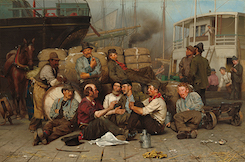
Industrial Revolution John George Brown, The Longshoremen'southward Apex, 1879, oil on canvas, National Gallery of Art, Washington, Corcoran Collection (Museum Purchase, Gallery Fund), 2014.136.ii
Painter John George Brown kept a studio in New York a few blocks from the Hudson River. He ofttimes walked downwards to the docks, where he paid longshoremen more than their going rate to pose for sketches. The Longshoreman'southward Apex illustrates a diversity of Irish and German language workers, as well as a sole African American man, sitting on and in front of bales of cotton ready to ship.
Before the advent of the shipping container, longshoremen were essential to waterfront operations. They loaded and unloaded ships, moving hundreds of pounds of cargo that physically taxed their bodies. Work was oft erratic, actualization and disappearing with the whims of shipping schedules, and steamships paid wages depending upon prevailing economic weather condition. New York longshoremen went on strike multiple times in the belatedly 1870s, while Brown worked on this painting. Information technology is thought that the men at center are discussing news of their efforts published in the Sun newspaper.
Journalists criticized Brown for idealizing his subjects, including these longshoremen. He avoided showing the full realities and challenges of urban life, acknowledging that he made works of art for the public and collectors to savor. Knowing its groundwork, what do you think about this painting?
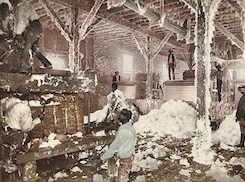
Industrial Revolution Detroit Photographic Visitor, Mississippi Cotton Gin at Dahomey, published 1899, photo-chromolithograph, National Gallery of Art, Washington, Gift of Mary and Dan Solomon and Patrons' Permanent Fund, 2006.133.130
What practice you picture when y'all think of cotton fiber?
This photograph shows the interior of what was once the world'due south largest cotton plantation. At left, African American men pack cotton into a large bale using a press; in the rear, cotton gins—machines that separate gluey seeds from establish fibers—are visible. Eli Whitney's invention of the cotton gin in 1793 accelerated cotton production in the Usa, equally well equally the use of slave labor to harvest and process the crop. By 1899, when this photograph was made, slavery had been abolished for over xxx years, merely cotton product was rebounding.
Dahomey Plantation was founded in 1833 by F. G. Ellis, who named the plantation after the Kingdom of Dahomey, the homeland of his enslaved workers in present-twenty-four hours Republic of benin. Ellis was probably able to claim the land at this time because thousands of Native Americans had been forcibly removed under policies and orders enacted by President Andrew Jackson.
Imagine yourself in this scene: What do you think it would have felt similar to work in this room? How does knowing the history of Dahomey Plantation and its country alter your thinking about the photograph?
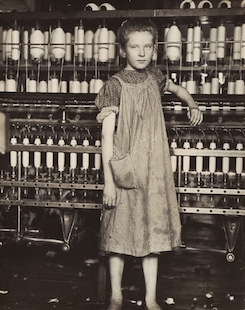
Industrial Revolution Lewis Hine, Addie Card, 12 years old. Spinner in cotton mill, North Pownal, Vermont, 1910, gelatin silvery print, National Gallery of Art, Washington, Pepita Milmore Memorial Fund, 2014.164.ane
Addie Card was one of thousands of child workers whom Lewis Hine documented for the National Kid Labor Commission from 1908 to 1924. The organisation hired him to investigate and photograph child labor practices beyond the Us.
Child labor increased in the 19th century as factories and industries grew, and it was especially common in textile mills. Families relied on their children for income and employers took advantage of their small bodies and fingers to fix machines and fit into pocket-size spaces.
Lewis Hine'south photographs drew attention to unfair and unsafe child labor practices. But it was not until 1938 that the Fair Labor Standards Human activity was passed, regulating child labor—though agronomical labor was and still is excluded. Imagine yourself in Addie Carte's place. What do y'all remember a typical 24-hour interval in her life would have been like?
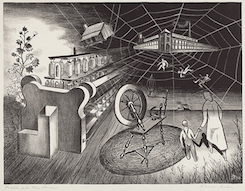
Industrial Revolution Lamar Baker, Walk Into My Parlor, 1940, lithograph, National Gallery of Art, Washington, Reba and Dave Williams Collection, Souvenir of Reba and Dave Williams, 2008.115.731
This print shows a montage of images related to the cotton industry in the South. In the foreground, a mother and kid walk away from a spinning wheel toward a cotton factory, which has defenseless other workers in its web. A alpine cotton fiber plant on the left is juxtaposed with factory mechanism.
By the 1930s, many southerners were trapped in the cotton industry's cycle, growing the ingather for cash and working the mills even as the market plummeted. The region's longtime reliance on cotton wool and its lack of industry diversification and job opportunities led to widespread poverty.
Lamar Baker, an artist built-in and raised in Atlanta, said his objective was to brand "social and moral comments by way of the lithographer's art." What social or moral commentary practise yous encounter in this piece of work?
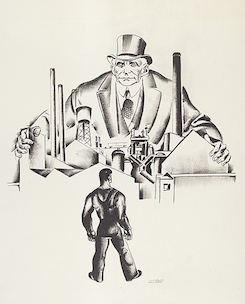
Industrial Revolution Hugo Gellert, Main Aggregating 3, 1933, lithograph, National Gallery of Art, Washington, Reba and Dave Williams Collection, Souvenir of Reba and Dave Williams, 2008.115.2026
Hugo Gellert made Primary Accumulation 3 for an illustrated book of Karl Marx's Das Kapital. Das Kapital was written in the mid-19th century equally the Industrial Revolution fundamentally altered work and life. Marx studied the English factory system and theorized that capitalism, with its ceaseless drive for profits and power, exploited workers and would eventually collapse.
Gellert selected what he called "essential parts" of Das Kapital and created corresponding prints. With this work, Gellert illustrated an aspect of primary (or primitive) accumulation, a concept which Marx described as a precapitalist phase wherein owners merits capital, often seizing it from others, in order to begin the capitalist cycle. Gellert shows the owners of production as more powerful and distinct from the working course. How does Gellert demonstrate the factory possessor's power?
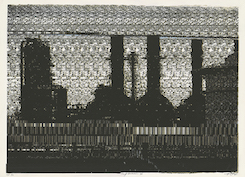
Industrial Revolution Soledad Salamé, Gulf Distortion XII, 2011, colour screenprint with interference pigments on plastic film, National Gallery of Fine art, Washington, Gift of Bob Stana and Tom Judy, 2016.148.46
Soledad Salamé traveled to Louisiana to certificate the aftereffects of the 2010 Deepwater Horizon oil spill. The well, operated by BP, spilled four.9 1000000 barrels of oil into the Gulf of Mexico over the grade of at least five months, making it the largest marine oil spill in history. This industrial disaster continues to negatively impact sea life and people living along the coast.
To create her Gulf Distortion serial, Salamé faxed the photographs to herself, deliberately distorting the images. She printed them on plastic film using an ink that produces a shimmery appearance. Why do you lot recollect she may have distorted the original photographs in this mode?
The Deepwater Horizon disaster raised questions about the petroleum industry, its environmental impacts, and how it is regulated. Compare this photograph to Von Storch Shaft, Del. & Hudson Canal Co. by Thomas H. Johnson. What similarities and differences do yous run across betwixt these two works of art?
















0 Response to "Art in the Industrial Revolution 19th Century Art in the European 19th Century"
Postar um comentário